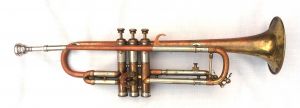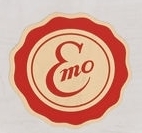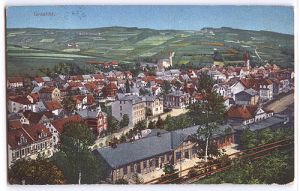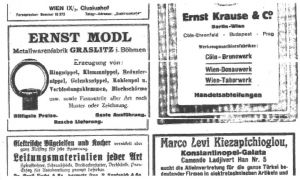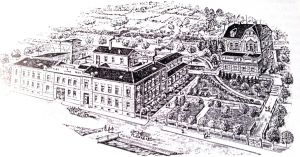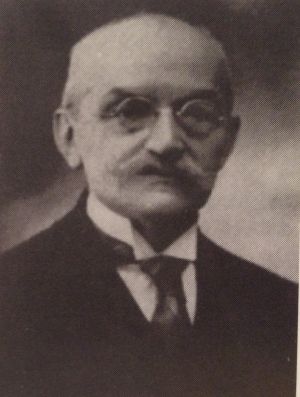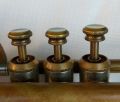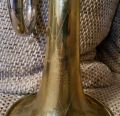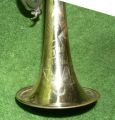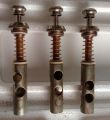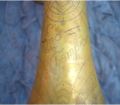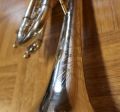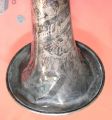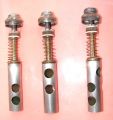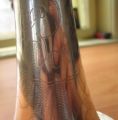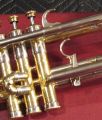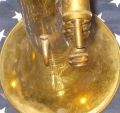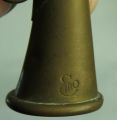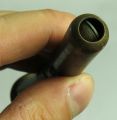Ernst Modl brass instruments
Under construction
Every now and then an Emo trumpet pops up on Ebay and other auction sites and a potential buyer asks: 'who knows more'. Little is known about it's maker Ernst Modl who's career started before WWI in Bohemia and ended after WWII in West-Germany. Often the link with Louis Armstrong is mentioned and there are these still available Emo mutes.
On this page I collected the available information. Starting with his pre WWII career in the F.X. Hüller company in Graslitz, the war years, his patents, and an overview of his instruments with serial numbers that appear not only under the Emo brand but also under names like Ludwig, Buffet Crampon, Rudy Muck, Smith Music Sales and Waterloo. Trying to connect things and hoping for additional information to come.
Note: This page focusses on brass and on the career of Ernst Modl. More information about F.X.Hüller and their (pre war)saxophone production you can find at F.X.Hüller.com
Contents
Before WWII
The life of Ernst Modl starts on July 4th 1892 in Graslitz, Czechoslovakia. Graslitz, now known as Kraslice, is a town close to the border with Germany. It was then part of the Austro-Hungarian empire. Graslitz housed an extensive production of musical instruments, brass and woodwind, but also harmonicas. The other economic pillar was textile industry. At the beginning of the 20th century, there were 86 middle and smaller textile factories and 11 musical instrument factories in Graslitz. There were also 40 independent companies that either produced musical instruments or their components. Until WWI the city was booming.
I'm not sure about the ancestors of Ernst Modl. There's a Josef Modl listed in 1771 as musical instrument trader, living at Modlgasse 371 (549) in Graslitz. One of his descendants was also called Josef Modl, rotary valve block maker and trader of wind and string instruments in the early 1900's at Modlgasse 542/786 in Graslitz, with his workshop founded in 1848. In 1913 Josef Modl is listed along with F.X.Hüller as one of the two Graslitz makers that participate in the newly registered O.Hebron exportfirm in Berlin, together with a lot of Markneukirchen based traders.
In the years of the First World War, the economic boom stagnated. In 1918, Austria-Hungary, to which Graslitz belonged, disintegrated, and the Czechoslovak Republic was founded. After WWI production in Graslitz quickly recovered and at a time there were 59 musical instrument manufacturers in the area including such names as Bohland & Fuchs, F.X.Hüller, A.K. Hüttl and Julius Keilwerth.
From ca. 1918 till 10-05-1920 Ernst Modl is listed as maker of rotary valve blocks (G.Dullat). In the catalog '400 Jahre Musikinstrumentenbau in Graslitz' Dullat also mentions Josef Modl at Modlgasse 542 (786), and he states that it's the same as Ernst Modl at Modlgasse 786, who's listed as 'Maschinen- und Metalblassinstrumentenbau sowie Herstellung von Geschossteilen". That could mean that Ernst was a son of Josef, wouldn't it?
The magazine Elektrotechnik und Machinenbau, Volume 37, Nr 8 has an ad on April 6th 1919 of Ernst Modl Metallwarenfabrik, Graslitz i. Böhmen (Bohemia), producing of all kinds of nipples, clamps and sheet metal screens. 'Best prices. Best performance. Fast delivery.' the ads says. It doesn't give a street name/address. So Ernst started a workshop on his own.
On 09/06/1919 Ernst Modl marries Philippine Hüller, the daughter of Franz Xaver Hüller. In 1922 a daughter is born. His father-in-law F.X. Hüller was a leading instrument maker in Graslitz. By 1910 Hüller had 200-250 people at work. He built and traded wind instruments and stringed instruments. Hüller, born on December 29th of 1856, in the nearby Pechbach founded his factory in 1882. He then bought the ruïns of the 'Knappschaftsmühle', a burnt mill, and on that spot in 1898 he had a factory and a house built. The factory was known as the 'Schied-Fabrik'. The address was Eibenbergerstrasse 440, now called Wolkerova in the Grunberg part of Graslitz (now: Zelená Horá in Kraslice). House nr 1066 is right behind the factory and is the Hüller villa at the Knappschaftsgasse/Nerudova (cást).
Ernst Modl joined the company in 1919 after he married Philippine. Her sister Susanne had married Anton Riedl (6/6/1884-11/25/1935) in 1911, who in taht same year joined the Hüller company. (note: this Anton Riedl is another one than the maker of the <strongArigra octagonal trumpets). In 1920 on the first of March Modl and Riedl together with Philippine and Susanne Hüller became partners in the company (Hüller himself was aged 63 by then). On March 29th 1920 the name of the company changed therefore in F.X.Hüller & Co (F.X.Hüller a Spol in Czech). Modl took on the role of the inventor and craftsman, while Riedl took care of the management and the sales. (Uwe Ladwig). 'He never built an instrument' (Rippert)
Ernst Modl brass instruments
Modl used the model names that we know from F.X. Hüller & Co: Professional, Champion and World, with the extensions Super, 'De Luxe', De Luxe Color and an incidental Standard, Ideal.... The serial numbers I found so far (some 160, including stencils) reach from 2 till 8125, with an outlier at 12750.
The typical Emo trumpet can be recognized by it's spherical waterkeys, the baluster style bracing and the sloping valve caps and "Selmer' style arched valve stem buttons. The Word models have these 'Olds' style valve casings and bottoms.
But on a closer look there is more variation, partly because for the early instruments standard parts were used.
Ernst Modl started in 1951 with the production of signal horns. The production of rotary valves was added and he picked up the production of bugles, trumpets (piston valves and a few with (top action) rotary valves). Also a few cornets, several slide trombones and a valve trombone are known and then euphoniums are mentioned (but I haven't seen any pictures of them).
Emo Trumpets
Emo Professional
The first few Professional trumpets have the octagonal valve caps and bottoms that are also found on Keilwerth and Wohlrab trumpets. After that they have round caps and bottoms. Then the typical baluster braces also pop up. The waterkey is a traditional one, and stays the same over the years. After finding it's form in the early years the Professional model hasn't changed.
Emo Professional, octagonal valve caps, traditional braces, valve numbers 1,2,3
Emo Professional, octagonal valve caps, serial number 4(?), valve numbers 1,2,3, traditional braces
Emo Professional serial number 2, round valve caps
Emo Professional Bb and C, serial number not known, spin with typical baluster
Emo Professional Bb and C, serial number 46
Emo Professional, serial number 4933, baluster and traditional brace
Emo Professional serial number 8103
Emo Champion
The Emo Champion trumpets all have normal waterkeys, no 'Emo' keys. Between 454 and 747 they get underslung waterkeys, then again normal waterkeys. Somewhere between 2506 and 2676 the valve buttons change from 'Emo' style to 'normal'. The bracings vary but the brace in the main tuning slide mostly is 'Emo'. Most of them have a forwarded position of the valve block ('balanced').
Emo Champion, serial number 18
Emo Champion, serial number 32, different engraving on bell
Emo Champion, serial number 509, underslung waterkey, braces in different styles, hexagonal valve buttons
Emo Champion, serial number 2676, different engraving on bell, underslung waterkey
Emo Champion, serial number 5681, underslung waterkey
Emo Champion Super
The Emo Champion Super all have the typical 'Emo' waterkeys and valve buttons. There's a little variation in the finger hoooks.
Emo Champion Super, serial number 632, different finger hook, 'Emo' waterkeys and valve buttons
Emo Champion Super, serial number 8125, 'Emo' waterkeys and valve buttons
Emo World
The Emo World trumpets have a pretty constant shape, with all the known Emo features, including the 'Olds' style valve casings. Most of them have a forwarded position of the valve block ('balanced').
Emo World, serial number 563, balanced
Emo World, serial number 1933
Emo World, serial number 7688
Emo World, serial number 12750, Bauerfeind valve block. The only Emo with a 5-digit serial number.
Emo World de Luxe
Emo World de Luxe have all the typical Emo features. From a certain point they also have a patented third valve slide hook. This patent from Modl dates from July 18th 1956.
Emo World de Luxe, serial number 1433
Emo World de Luxe, serial number 3865, and the third valve slide hook
There's also a multicolored World de Luxe, the World de Luxe Color. So far only in low serial numbers (81-576).
Emo World de Luxe color, serial number 81
Emo Standard
A rare bird. An Emo Standard, with also F.X.Hüller engraved on the bell. Sold in an auction in Stockholm in 2019. It's the only Emo Standard and also the F.X.Hüller & Co name is seldom used, although it's also found on the trumpet Louis Armstrong got with serial number 2503 but that one got a special inscription with Armstrongs name on it as well.
Emo Standard, F.X.Hüller & Co, serial number 492
Other Emo brass instruments
Trombones
So far I've found several Emo trombones, only the Champion model. The slide trombones seem to have no serial number, apart from one with an 18 on the mouthpiece reciever.
Emo Champion trombone. No serial number.
Emo Champion valve trombone. Serial number 172
Cornet
There are some Emo cornets around but not many. So far World is the only model I found.
Emo World cornet
Emo cornet
Flugelhorn
There is one flugelhorn model Champion known. A low serial number so maybe Modl stopped pretty soon producing them.
Emo Champion flugelhorn, serial number 179
And another one, no model name known but with baluster type braces.
Emo flugelhorn, source Horn-u-copia.net9
Rotary valve trumpet
I found one example of an Emo rotary valve trumpet.
Emo rotary valve trumpet, no serial number
Top action rotary valve trumpet
Modl also made a few top action rotary valve trumpets in various pitches, Eb, Bb and C.
More about these at the Top action rotary valve trumpets page of Brasspedia.
Signal horns
Signalhorns come in different sizes, used by cyclists, fire brigade, train people, hunting and as a foghorn. Other than trumpets they have a harmonica like reed that makes the sound.
Emo small signal horn, 10,15 cm long and sounds like a harmonica, source Ebay.com 2017
Emo signal horn, 28,5 cm long and sounds like a harmonica, source Ebay.de 2019
Emo signal horn, 45 cm long, used at the Reichsbahn, source Ebay.de 2019
Bugles
There are a few Emo bugles, all with one valve, presumably from Bb to Eb. As they all seem to have hexagonal valve caps, I guess they are from the early years.
Emo signal horn, dating before 1965
Emo bugle converted to a lamp....
Emo bugl , source Horn-u-copia.net
